Dal tadka is synonymous with Malaysian Indian restaurants for me. Whenever I talk about dal tadka, there will be a mental picture drawn immediately about these eateries that flourish in every nook and cranny in Kuala Lumpur.
Dal tadka is immensely popular in Malaysia. The Malaysian Indians are Southern India’s descendants who populated dal tadka to become an indisputable favorite food for all Malaysians, irrespective of race and culture.
I will explain how to make dal tadka, which involves some specific ingredients which may only be available in the Indian grocery or online store. It may not be the easiest recipe, but the taste and aroma are worth the time and effort spent. Please check this easy dhal recipe if you want to take a shorter route.

Note: This post may contain affiliate links. Please read my privacy policy for more info. I may receive commissions for purchases made through links in this post. As an Amazon Associate, I earn from qualifying purchases.
Tadka, the tempering method that makes dal tadka special
The preparation of dal tadka involves many herbs and spices. Tadka means tempering, a cooking technique commonly used in Indian cuisine. It is a method to heat the cumin seeds, curry leaves, garlic, and other spices in ghee, releasing the oil-soluble flavor and infusing into the ghee. It is the ghee perfumed by the spices that make dal tadka incredibly addictive and tasty.
How to prepare dal tadka
Dal means lentil in Hindi. The most commonly used lentil for dal tadka is toor dal (yellow lentil), but it is nice to add a small amount of Masoor dal (red lentil) for a different texture. You can also add some moong dal or a combination of these.
Here are the steps:
1. Cook the dal (lentil)
Clean and soak the dal
- Before you start, check whether the dal is clean. Usually, it is relatively clean and free from sand and debris. If you are worried about the cleanliness, sieve the lentils with a colander before washing it.
- Wash the dal by changing the water a few times until it runs clear.
- Soak the dal with sufficient water. After thirty minutes, the lentil will absorb plenty of water and expand. Soaked lentil takes a shorter time to cook.
Simmer the dal
- Add the soaked lentils, turmeric powder, and salt to the boiling water. When the water is boiling again, lower the heat to simmer the dal over low heat until it becomes soft and disintegrate.
- It takes me forty-five minutes over the stovetop but is shorter with a pressure cooker.
The bubbles during cooking
There will be plenty of bubbles forming on the surface, which looks like it is soaked in soup water. The saponin creates the bubbles. It works like soap, foam up, and forming bubbles when cooking or during agitation. The amount of foam can be reduced substantially by rinsing the lentils thoroughly before cooking.
So is it necessary to skim off the foam and scum? There is no culinary benefit to skim it off, although you can choose to do it. Indeed, this step will become impossible if you cook it with a pressure cooker.
You may find the dal is slightly watery initially, but keep in mind that it will become thicker after it cools.
2. Cooking the herbs and spices
- Heat some ghee in a frying pan over medium heat. You may use olive oil or other vegetable oil with a high smoking point, but ghee produces the best flavor. Add the cumin seeds and wait until it starts to splutter and the volume begins to swell.
- Now add the mustard seeds and curry leaves and temper for half a minute.
- Since I have blended the ginger, garlic, and green chilies, I pour it into the spices and cook until the water dries up and turns aromatic. You may want to chop them finely if you have not made the ginger garlic paste in advance.
- Add the chopped onion and saute with the spices until it becomes soft, translucent, and tender, which will take about 2 to 3 minutes. While cooking the onion, add the garam masala, Kashmiri chili powder, and kasuri methi.
- After the onion is ready, pour in the chopped tomatoes and continue cooking for about 5-7 minutes until it starts to disintegrate.
- When the tomatoes have become very soft, combine the spice mixture with the dal that we have cooked. Boil for another few minutes until it becomes homogeneous. Sprinkle some chopped coriander leaves and season it with salt.
3. Temper the spices
Heat some ghee in a separate tadka pan (a specially made small pan for tempering). You can use any small frying pan if you do not own one.
It is recommended to use a generous amount of ghee for tempering to get the best result. Add the cumin seeds and wait for it to start crackling, followed by hing, dried chilies, and some Kashmiri chili powder.
When all the spices turn aromatic, keep part of the spices aside, and pour the rest into the dal while still boiling. Mix well.
If you want to skip the smoke infusing step (optional), go straight to step 5.
4. Infuse the smoke flavor with the dhungar method (optional)
The dhungar method uses burn charcoal to infuse a buttery, smoky flavor as a finishing touch to the dal. This step is optional and should be done before adding the reserved portion of the tempered spice and garnish.
- Heat a small piece of charcoal on a wire rack over the stove.
- Put a trivet or other similar support in the pot of dal, place a small metal container on it to hold the charcoal, and small enough to put on the lid.
- When the charcoal is hot, place it in the metal container and add two teaspoons of ghee.
- Cover to keep the smoke inside the pot. The smoke will infuse the aroma into the dal.
- Remove the charcoal after five minutes. You can increase the intensity of the smoke flavor by increasing the duration of up to ten minutes.
5. Garnish and serve
- Pour the dal into the serving bowl or container
- Heat the reserve spices and oil until sizzling, then pour it onto the dal.
- Garnish with more coriander leaves and serve.
How to store dal tadka
I usually keep it for one to two days in the refrigerator and freeze it if I intend to keep it longer.
Frozen dal is a lifesaver when you are sick or too lazy, even to cook a simple meal. It can be kept in the freezer for up to a month. You can reheat the dal with some additional water if it is too thick.
Common ingredients used in making dal tadka
Most of the ingredients for making dal tadka are the regular items for anyone who likes Indian dishes. You may skip this section if you are familiar with these items, but it serves as a brief introduction if you are new to Indian cooking.
Toor dal
Toor dal is also called pigeon pea, Arhar dal, or yellow dal. It is the most common type of lentil for making dal tadka. You can also add a small amount of masoor dal (the split red lentil) to get a different texture.
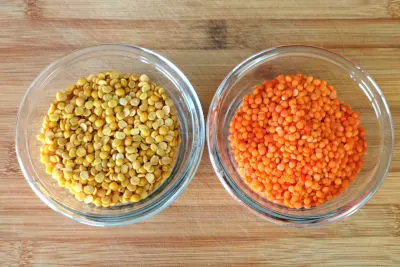
Ghee
Ghee is purified butter with the milk solids removed. Traditionally ghee has been used for cooking most of the Indian food. It has a higher smoking point (up to 250°C/480°F) and is suitable for frying, sauteing, and tempering the spices. The fat-soluble flavor is preserved when the spices are tempered under the smoking point.
Butter is not ideal for tempering the spices since butter has a low smoking point (175°C/350°F). If ghee is not available, use other vegetable oil with a high smoking point (corn oil, peanut oil, palm oil, sunflower oil).
Cumin seeds and mustard seeds
Cumin seeds are used in Indian dishes to infuse the oil with flavor. It has a pungent taste and is rich in aroma, which is essential in all the dal recipes. Cumin powder is not a perfect substitute because the flavor is weaker.
Mustard seeds work similarly to cumin seeds to infuse the oil. It has a smoky and nutty flavor and is also used in other dishes such as cabbage thoran. Some dal tadka recipes do not use them as cumin seeds are deemed sufficient.
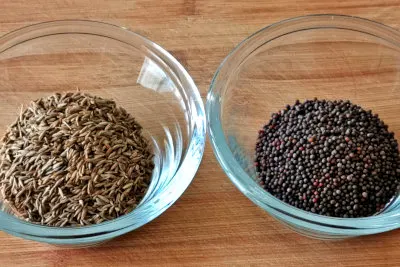
Curry leaves
Curry leaves have a unique citrusy and aromatic flavor. It is used as an ingredient for tempering and to cook other curries. It is used beyond Indian food and is a crucial ingredient for my Malaysian Chinese style butter prawns.
Ginger, garlic, and green chili
Many households prepare the ginger garlic paste in advance. You can also purchase ready-made paste for convenience. However, it is not hard to make the paste, as the only step is to blend the equal amount of garlic and ginger, with a little oil added to facilitate blending.
I blend the ginger, garlic, and green chili in this recipe because I want a smooth texture. You may finely chop these ingredients if you wish.
Garam masala
Garam masala is a spice blend widely used in Indian cuisine, from curry to dal to soup. It is a mixture of cinnamon, mace, peppercorns, coriander, cumin, and cardamom. The Chinese cuisine also used a similar spice mixture called five-spice powder (star anise, cloves, cinnamon, Sichuan peppercorns, fennel seeds).
Chili powder
Kashmiri chili powder is relatively mild in heat, full of flavor, and with vibrant red color. Since it is not very hot (with 1,000 to 2,000 Scoville Heat Units, or SHUs), it is used as a coloring agent apart from its flavor and heat.
A suitable substitute is to mix one part of cayenne (50,000 SHUs) with three parts of paprika (1500 SHUs) if it is not available.
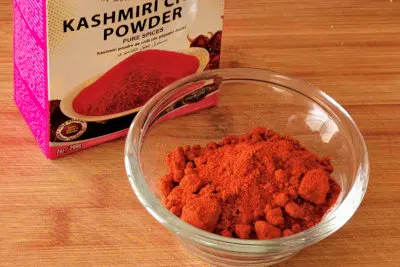
Kasuri methi (Fenugreek)
Kasuri methi is the sun-dried fenugreek leaves. It has a flavor similar to the combination of fennel and celery and is slightly bitter. It is sold in the dried leaves or powder form. You can substitute it with one tablespoon of celery leaves for each teaspoon of dried kasuri methi, although the flavor is not entirely identical.

Hing
Hing (or asafoetida) is derived from the resin of the plant in the Ferula family. The sap is dried and becomes a hard resin, which is then ground into small granules. It has a pungent taste, lightly spicy with onion flavor. There is no direct substitute, but you can substitute one part of hing with one part of garlic powder plus one part of onion powder to get the approximate taste.
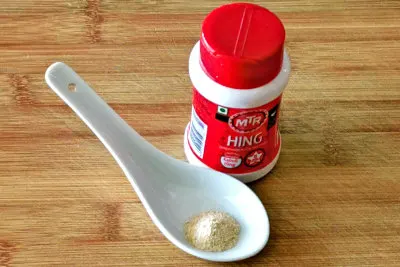
Related articles to Dal Tadka
Please check out the following recipes if you like dal tadka. These Indian recipes are best to serve with dal:
Chapatti: Indian flatbread that is is healthy, cook without oil, and best to serve with curries and dal.
Cabbage thoran: Indian fry cabbage that involves the tempering method as in this dal recipe.
Oven-baked tandoori chicken: Make this spiced chicken dish with the electric oven instead of the tandoor.
Chicken biryani rice: One of the most delicious and rich rice dishes, perfectly served with any dal and curries.
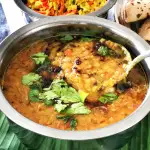
Dal tadka - How to cook (authentic recipe with useful tips)
Dal tadka is a popular Indian vegetarian dish flavored with tempered spices. It is prepared with lentil and is best served with rice and rotis.
Ingredients
To boil the dal
- 400g toor dal, soak for 30 minutes
- 1 tsp turmeric powder
- 2 tsp salt
- 1.5 liter (7 cups) water
To cook the spices
- 4 tbsp ghee
- 2 tsp cumin seeds
- 1 tsp mustard seeds
- 2 sprigs curry leaves
- 8 cloves garlic, finely chopped
- 2 inches ginger, finely chopped
- 2 green chilies, finely chopped
- 300g onion, finely chopped
- 400g tomatoes, finely chopped
- 2 tsp coriander powder
- 1 tsp garam masala
- 1/2 tsp Kashmiri chili powder
- 2 tsp kasuri methi
- 2 tbsp coriander leaves
- Salt to taste
For the tadka.
- 2 tbsp ghee
- 1 tsp cumin seeds
- 1/2 tsp hing
- 4 dry chilies, cut and remove seeds
- 1/2 tsp chili powder
For dhungar (optional)
- 1 small piece of coal
- 1 tbsp ghee
Instructions
Cook the dal (lentil)
- Clean and soak the dal
- Wash the dal by changing the water a few times until it runs clear.
- Soak the dal with sufficient water for thirty minutes,
- Add the soaked lentils, turmeric powder, and salt to the boiling water. Simmer for forty-five minutes.
Cooking the herbs and spices
- Heat some ghee in a frying pan over medium heat.
- Add the cumin seeds and wait until it starts to splutter.
- Now add the mustard seeds and curry leaves,
- Blend the ginger, garlic, and green chilies and add to the spices.
- Add the chopped onion and saute with the spices until it becomes soft. Season the dal with garam masala, chili powder, and kasuri methi.
- After the onion is ready, pour in the chopped tomatoes and continue cooking for about 5-7 minutes until it starts to disintegrate.
- Combine the spices with the dal. Sprinkle the chopped coriander leaves and season it with salt.
Temper the spices
- Heat some ghee in a small frying pan.
- Add the cumin seeds and wait for it to start crackling, followed by hing, dried chilies, and some Kashmiri chili powder.
- When all the spices turn aromatic, pour the rest into the dal while still boiling. Mix well.
Dhunger method - Infuse with smoke flavor (optional)
- Heat a small piece of charcoal on a wire rack over the stove.
- Put a trivet in the pot of dal, place a small metal container on it.
- When the charcoal is hot, place it in the metal container and add two teaspoons of ghee.
- Cover to keep the smoke inside the pot for five minutes. Remove the charcoal and the metal container.
Garnish
- Garnish with the reserved tempered sices and coriander leaves.
Recommended Products
As an Amazon Associate and member of other affiliate programs, I earn from qualifying purchases.
-
 Rani Asafetida (Hing) Ground 3.75oz (106g) ~ All Natural | Salt Free | Vegan | NON-GMO | Asafoetida Indian Spice | Best for Onion Garlic Substitute
Rani Asafetida (Hing) Ground 3.75oz (106g) ~ All Natural | Salt Free | Vegan | NON-GMO | Asafoetida Indian Spice | Best for Onion Garlic Substitute -
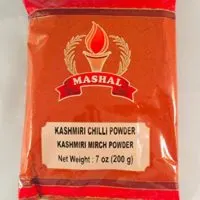 Mashal Kashmiri Chili Powder 7 oz (200 gm)
Mashal Kashmiri Chili Powder 7 oz (200 gm) -
 Rani Fenugreek Leaves Dried, All Natural (Kasoori Methi) 28g (1oz) ~ Gluten Free Ingredients | NON-GMO ~ Vegan
Rani Fenugreek Leaves Dried, All Natural (Kasoori Methi) 28g (1oz) ~ Gluten Free Ingredients | NON-GMO ~ Vegan -
 WhopperIndia Nonstick & hard anodised tadka pan / spice roasting pan / vagharia with long handle 11 Inch
WhopperIndia Nonstick & hard anodised tadka pan / spice roasting pan / vagharia with long handle 11 Inch
Nutrition Information:
Yield: 8 Serving Size: 1Amount Per Serving: Calories: 203Total Fat: 13gSaturated Fat: 7gTrans Fat: 0gUnsaturated Fat: 5gCholesterol: 29mgSodium: 773mgCarbohydrates: 19gFiber: 5gSugar: 6gProtein: 6g
This data was provided and calculated by Nutritionix on 11/16/2020

Linda Alderete
Thursday 17th of December 2020
Very good. Thank you
KP Kwan
Friday 18th of December 2020
You are welcome.
Long
Monday 30th of November 2020
I made this for dinner tonight and it was absolutely brilliant. Lovely flavours and simple to make. I didn’t have the things for the dhungar method so I’ll have to try in the future. Thanks you so much
KP Kwan
Tuesday 1st of December 2020
You are welcome and glad that you like this dal tadka recipe.
Sharmini
Saturday 21st of November 2020
Can I use canned lentils
KP Kwan
Sunday 22nd of November 2020
Hi Sharmini, You can use canned lentil, but I think that is the next best thing if the fresh one is not available. I have not tried using canned lentil so far, but please look at what type of lentil is in the can and adjust the simmering time if it is already cooked. KP Kwan
Ravi
Thursday 19th of November 2020
So much for the humble Dal that is staple here!! Its the easiest thing to cook along with rice for Indian mothers!! :)
Nico Vosloo
Thursday 19th of November 2020
It looks good I soppose it taste very good